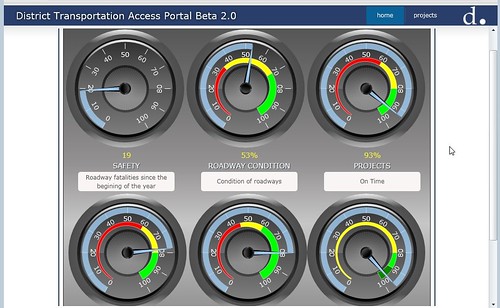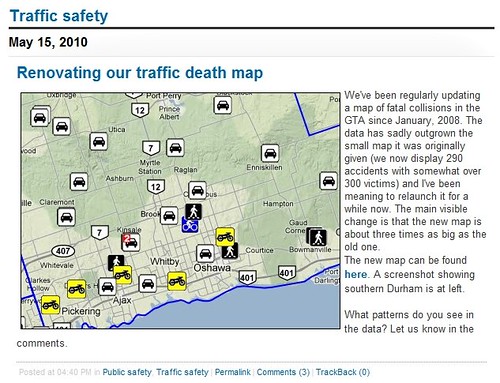DC DDOT transportation access portal doesn't really say anything

One of the problems with all the hype about Web 2.0 is that people too often focus on the attractive graphics, and not the depth and breadth of what is provided. Some apps are great. Some apps seemingly pump out and disclose data, but communicate little of substance.
Such is with the heralded DC Transportation Access Portal.
By publishing only a gross number/statistic, and not providing a way to drill down deeper into the data, little actionable information is provided.
In the DDOT TAP only one of the six buttons, projects (the other five are safety, roadway condition, transit, finance, and customer service), allows the ability to drill down for additional information.
What it provides is a start. It could be great, but there is no question that the data for active DDOT construction projects, organized by Ward, is incomplete. I know it's incomplete because on 3rd Street NW there has been a sidewalk and roadway improvement program going on (I have been meaning to write about it), funded by ARRA, and it isn't listed.
Plus there is an issue of quality of the finished project. For the most part, the ones I've seen are good. But there are other issues.
Still, this is a model for what should be happening with each of the other buttons. For example, with the roadway conditions button, you ought to be able to drill down into a master database of road condition information for every block of every street on which the data has been collected.
With safety, since one of the buttons is for traffic fatalities, there is no way to drill down to three different additional layers of vehicle fatalities, pedestrian fatalities, and bicyclist fatalities--actually the data should be for accidents overall, not just fatalities.
This information is collected, it's just not disclosed. And if there are places where multiple accidents occur, then it is likely that there are potential "countermeasures" that can be employed to address structural/design problems that may contribute to fatalities. That's the purpose of the FHWA Pedsafe and Bikesafe programs--used for analysis of particular types of categorizable accidents, with proposed responses.
DCist and GGW have been mapping this information, but it isn't actionable...
In the past I wrote about an online mapping project that was conducted by the Toronto Star ("Mapping bicycle-car and pedestrian-car accidents"). Sadly, they have discontinued the project, but it was quite pathbreaking, and a model for what DDOT could be doing with its dashboard, and for "Apps for Democracy" as well -- more data of significance and less fluff and hype.
-- Toronto Bike Accident Map, 2008

Toronto Star traffic death map
FWIW, I have been writing about this issue, the disclosure of information to the public, measurements and metrics, for longer than I have been blogging. Below is something I wrote in themail in 2004:
What Gets Measured Gets Done
Richard Layman, rlaymandc@yahoo.com
In the classic business book In Search of Excellence, the authors coined the famous phrase "what gets measured gets done" to refer to companies that outperform their peers because of a greater focus on what matters. Of course, being sure that organizations focus on what matters is always a problem, as is a focus on accountability. Today's Austin American-Statesman talks about how the City of Austin updates 4,000 different performance measures weekly, from library circulation statistics to how the city is meeting its goals, and it posts this data to the city website. This is an expansion of their public communication of such data, which since the mid-1990s had been published quarterly. (See http://www.ci.austin.tx.us/budget/eperf/index.cfm for the website.)
Similarly, the Citistat program in Baltimore is a finalist in Harvard's Ash Institute annual program highlighting governmental innovation. The program is written about by syndicated columnist Neal Peirce. Citistat marries data tracking and analysis with accountability for improvement, comparable to the CompStat program initiated by Jack Maple and William Bratton in NYC, a program which led to big change in policing strategies and tactics, and a concomitant reduction in crime. Peirce quotes Mayor O'Malley stating that “success comes only with constant and intense executive pressure, plus relentless follow-up with departments.”
I looked at the government services section of http://www.dc.gov, but I haven't been able to locate similar data sets. We need them
Labels: data and analysis, management of cities, provision of public services



1 Comments:
Thank you again for your flawless service, and I look forward to working with you in the future.
Post a Comment
<< Home